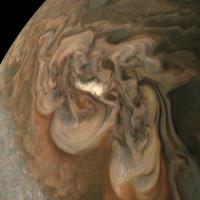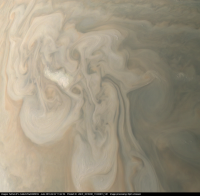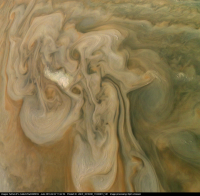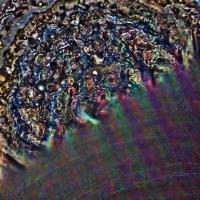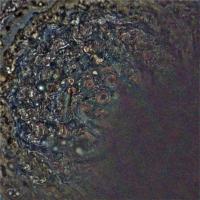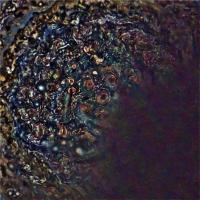Printable Version of Topic
Click here to view this topic in its original format
Unmanned Spaceflight.com _ Juno _ Juno, perijove 11
Posted by: Gerald Feb 8 2018, 12:41 AM
Part of the perijove-11 data have already been downlinked. So, we should start an according topic.
Here a thumbnail simulation I've rendered a few days ago, in order to see, how Jupiter may appear in JunoCam images:
The simulation is based on SPICE kernels as they have been available last week. Simulated shading is of Lambertian type by solar incidence.
The short appearance of a small portion of a mirror image of Jupiter in the upper and lower left corner indicates an apparent vertical extension of Jupiter of more than 180 degrees in cylindrical coordinates, which is strange. I wonder, whether that's a glitch in my calculations, or whether it can be explained by Juno's curved trajectory close to Jupiter, while JunoCam is taking the simulated image over about 15 seconds.
I don't mean the mirror image (which doesn't appear in real images), but the extension of more than 180 vertical cylindrical degrees.
Posted by: Gerald Feb 9 2018, 04:20 AM
... and #017:
Those are the RGB images of Perijove-11, downlinked and available as raws on the missionjuno site thus far.
I've rendered with 60 deg x 180 deg FOV, cylindrical equidistant seen from the spacecraft at image stop time.
The PNG version is submitted to the missionjuno site.
Some images actually cover more than 180 degrees vertically. After some pondering, I think, that's mostly due to the spacecraft's spin axis relative to Jupiter's surface.
Posted by: Explorer1 Feb 9 2018, 04:44 AM
Gosh, that's one bright cloud pattern at #13 (and near the edge in #12)! It almost looks overexposed...
Posted by: mcaplinger Feb 9 2018, 06:49 AM
It's bright but not that bright in the MSSS processed version, so I'm thinking this is an artifact of Gerald's processing.
Posted by: Gerald Feb 9 2018, 10:57 AM
The images are enhanced to the 4th power of radiometric values after approximate illumination adjustment. Small locally slightly brighter areas of linearized data can result much brighter. I'm allowing a small area (less than 0.1%) of the image to be saturated. Otherwise I'd either allow the majority of the image to be very dark, or else use another method to stretch brightness. But this would either reduce reproducibility and physical simplicity (and hence natural appearence), or reduce contrast (by using a smaller gamma). So, the applied solution is a compromise I've assessed as reasonable for most of the cases.
Overexposed portions of raw images usually show up as a strong colored cast, since the camera channels differ in their sensitivity, and overall bright areas are usually divided away to moderate values by the applied illumination adjustment method.
I'll upload drafts later, where you can check for overall brightness in the raws, although they might be saturated, too, in the blue channel, despite the raws not being saturated. That's then due to a fixed radiometric correction factor of larger than one for the blue channel. Again, the images would be very dark, or much less systematic and comparable, if I would strictly rule out this scenario.
Nevertheless, it can well be reasonable to apply different ways of processing, depending on the respective purpose.
In this special case of the bright cloud, we've seen bright clouds near the center of storm systems, before. Those are likely particularly high clouds, possibly due to a fast upwelling near the center of some (cyclonic) FFRs. And with the perihelion of Juno's orbit gradually drifting towards northern latitudes, we get closer to these FFRs.
Posted by: Gerald Feb 9 2018, 03:54 PM
The PNG versions of the above images are online on missionjuno, since several hours now. http://junocam.pictures/gerald/uploads/20180209/.
And http://junocam.pictures/gerald/uploads/20180209a/ with gamma=0.5, and without trajectory nor shape data, if you like to get close to whatever "natural colors" might mean for electronic displays.
Here a 50% reduced JPG, where you can see structure within the bright cloud, again enhanced to the 4th power of approximately illumination-adjusted radiometric data:
The twice supersampled PNG version is submitted to the missionjuno site.
Posted by: JRehling Feb 9 2018, 06:24 PM
There's so much to like here. Great work, once again!
I am struck by the color in that bright cloud: Specifically, the nonuniformity of it. And, again on the note that this non-science instrument may yield some impressive science, I wonder of the utility of this image, and others like it, for providing insight as to the still-unknown chromophores in Jupiter's clouds. If the chemical reactions that produce chromophores are produced at different combinations of altitude and solar incidence, images showing variations in hue in cloud surfaces that have freshly risen could potentially rule out some candidate reactions/compounds.
There is certainly variation in hue over that bright cloud. How much is due to compositional variation and how much due to variations in illumination is another question. I'm sure it wouldn't be trivial to perform the required analysis, but this is one of the first images I've seen that suggests that it's possible.
Posted by: Sean Feb 9 2018, 09:38 PM
Lovely work Kevin!
Here are my initial attempts with...
PJ11_12 [Gerald Eichstadt]
https://flic.kr/p/22QEHDF
&
PJ11_13 [Matt Brealey] *updated to full res*
https://flic.kr/p/238qdCQ
Posted by: Bjorn Jonsson Feb 10 2018, 12:53 AM
Here is my preliminary processing of image PJ11_13 in an approximately true color/contrast version and an enhanced version. This image includes the very bright cloud feature discussed earlier in this thread. I was careful not to saturate it during the processing. These images have been cropped and are also enlarged by a factor of 1.2 relative to the original images.
Posted by: Sean Feb 10 2018, 01:20 AM
Here is PJ11_11 [G.Eichstadt]
https://flic.kr/p/22QUbWv
Posted by: Sean Feb 11 2018, 12:31 PM
PJ11_13_crop [G.Eichstadt]
https://flic.kr/p/24cBjkq
Posted by: Gerald Feb 12 2018, 06:07 PM
I am struck by the color in that bright cloud: Specifically, the nonuniformity of it. And, again on the note that this non-science instrument may yield some impressive science, I wonder of the utility of this image, and others like it, for providing insight as to the still-unknown chromophores in Jupiter's clouds. If the chemical reactions that produce chromophores are produced at different combinations of altitude and solar incidence, images showing variations in hue in cloud surfaces that have freshly risen could potentially rule out some candidate reactions/compounds.
There is certainly variation in hue over that bright cloud. How much is due to compositional variation and how much due to variations in illumination is another question. I'm sure it wouldn't be trivial to perform the required analysis, but this is one of the first images I've seen that suggests that it's possible.
This, and other questions are going to be discussed on a new tab on the missionjuno site, called "https://www.missionjuno.swri.edu/junocam/think-tank".
The last inconsitencies I've been aware of have been fixed early today, such that I think, that I can point to this new feature now.
Candy's basic idea is an experiment with "science in a fishbowl", as far as it's possible with topics that are eventually intended to be published in regular peer-reviewed papers.
Within https://www.missionjuno.swri.edu/junocam/think-tank?id=15, I've posted links to a first set of PJ11 maps. They will e.g. help to narrow down the locations in terms of longitude and planetocentric latitude, which areas will be worth to render in high resolution, in order to measure small-scale features, like the bright cloud and its structure.
Regarding the color, it's always better to have at least two images of the same target to mostly rule out camera and processing artifacts.
Posted by: Gerald Feb 12 2018, 11:23 PM
#31, #32, #33, and #34:
The latter three have been taken with TDI 1, 3, and 6.
Posted by: Gerald Feb 12 2018, 11:32 PM
#35.#40, #41, #42, and #43:
with some more south polar views.
The according PNG versions are submitted to missionjuno. Only for #19, I've overlooked two processing artifacts (in the upper and lower left corners) in the version I've submitted to missionjuno.
Posted by: JRehling Feb 13 2018, 04:19 PM
That's great to know, Gerald. I'll enjoy seeing it.
With the chromophores question, there's a bit of a real world case here of "How do you know the refrigerator light goes off when you shut the door?" Or, the somewhat more mystical quantum mechanical question (yes, facetious) "Is the Moon still there when I don't look at it?" If sunlight plays a role in the creation of chromophores, and nobody doubts that it does, getting multiple observations, or even a single observation, is troubled a bit by the expectation that the phenomenon in question will vary over any set of observations. If the chromophores evolve (chemically or physically or via transport) much faster than a single Juno orbit, then we may have to rely upon a single hours-long perijove to study this phenomenon. Or, of course, several perijoves, studying the phenomenon longitudinally. (For example, you don't need to visit a city for 80 years to understand how people of all ages dress. You can see children, teenagers, young adults, older adults in one hour and piece together the timeline from those many cases.)
So, it may be informative to image the same active cloud formation twice in a perijove, but here I think the secondary role of imaging runs afoul of the mission's top priority, which wouldn't allow that sort of wasteful repointing.
In any event, good job and thank you for reducing the raw data to the point where such questions can even be asked!
Posted by: Gerald Feb 13 2018, 06:39 PM
Regarding the quantum physical question: When I don't look to the moon, but I see my shadow on the floor, I know, that the moon is there, and forced its wave function to collapse/decohere in my branch of the wave function of the universe.
Regarding Jupiter's chromophores: If the question of the photochemistry of chromophores in Jupiter's atmosphere has a convincing chance to be solved by a sequence of JunoCam images, we can ask for an according campaign, if that's even necessary, since we already have image sequences of the same target area, and the chromophores may need to make their (quantum-physical analog of a) decision, how stable they are.
My expectation is, that they are considerably longer-lived than one Jupiter day. With a global statistical analysis, we'll get mostly shading and scattering effects. Those might be able to be used to make conclusions about the grain size distribution of aerosols in Jupiter's upper atmosphere. We won't distinguish easily effects by polarization. Modeling and subtracting these ingredients might eventually add some constraint to the chemical stability of the chromophores. But if chromophores would change rapidly under sunlight, I'd expect this to be pretty obvious by a systematic change of Jupiter's color as a function of solar illumination, or of distance from the terminator.
I'd think, that long-term changes can be evidenced a little better by considering the bluish hue over Jupiter's polar regions compared to lower latitudes. But even here, we need to consider the overall structure of Jupiter's atmosphere depending on latitude that might act as a latitude-dependend color filter. So, it's certainly a long way to conclusions about microscopical dynamics and photochemistry, at least on the mere basis of JunoCam images.
I'll try to contribute my part to pin these things down as far as the data allow.
Posted by: Sean Feb 14 2018, 05:17 PM
Here are versions of PJ11_28 processes by Matt Brealey & Gerald Eichstädt respectively...
https://flic.kr/p/GdmxX3
https://flic.kr/p/EG7f2D
Posted by: JRehling Feb 14 2018, 06:39 PM
The Moon question is a bit of a facetious one, but one already in the QM community. ("Is the Moon There When Nobody Looks?" is the title of a very intriguing, but very off-topic paper by David Mermin.) Seeing one's shadow violates the spirit of the premise, which is, does physical reality exist when unobserved in any way?
That could take us far off topic, but the relation to Jupiter's chromophores is: If they form rather quickly upon exposure of some fresh, upwelling white clouds to certain conditions of sunlight, it may be pernicious-bounding-on-impossible to witness the process taking place, because the daylight that permits the process alters the conditions.
Even there, I'm being a bit over-wary. We have no idea if the chromophores form on such a rapid timeframe. If they form over a span of hours or days, there's no inherent difficulty. If they form via a process that begins and completes on the scale of seconds or minutes, we do have a problem. But that's just a conjecture to point out the potential difficulty. But in no case do I expect quantum mechanical superpositional states to be a relevant phenomenon.
I certainly agree that the chromophores last longer than a day. We don't (generally) see any profound color differences between parcels of cloud between the morning and evening circumstances. It may be that the chromophores are relatively permanent once created, in which case the only part of the process that we will get to observe will be the creation.
There are certainly many thorny variables: Vertical transport, temperature, solar (UV) illumination, altitude, and then the entire chemistry book. I don't know how close we are to understanding the phenomenon, but these Juno photos certainly seem to offer a new kind of observation in support of understanding it.
Posted by: Gerald Feb 14 2018, 09:32 PM
Here are three delayed outbound PJ11 images:
http://junocam.pictures/gerald/uploads/20180214/.
The PNGs are also submitted to missionjuno/processing.
[I might find some time later to discuss the chromophores]
Posted by: Gerald Feb 14 2018, 11:34 PM
In Seán's comparison, you can nicely see the effect of brightness stretch without, and with partial illumination adjustment. When you don't adjust for illumination, the darker parts of Jupiter approximate black on gamma stretch.
----
Quite simple, https://en.wikipedia.org/wiki/Copenhagen_interpretationisn't applicable without an observer. You'll need to switch to a more symmetrical version of QM, where the observer is part of the system. In this version, assuming the non-existence of an observer would mean the non-existence of the moon, since parts of it could otherwise play the role of an observer.
You missed possibly, that some spectral constraints are available. Those have been, and are going to be used to find best fits, or to rule out some chemical settings. So you can narrow down, which photochemical processes are to be considered. We also have ideas of which small molecules are available in Jupiter's atmosphere, like molecular hydrogen, ammonia, methane, water, and others. Those can be analysed regarding their decomposition under UV, together with the reaction paths of the formed radicals, constrained by the spectroscopic data.
https://arxiv.org/abs/1706.02779. There are certainly some competing schools with different approaches, and at the end it could turn out, that a planet more than 1,000 times the volume of Earth could be more diverse than everyone thought...
Posted by: Sean Feb 15 2018, 03:07 PM
PJ11_26 [G.Eichstadt]
https://flic.kr/p/231npj8
Posted by: JRehling Feb 16 2018, 05:31 AM
Thanks for the link, Gerald. Really looking forward to reading that paper.
Posted by: Gerald Feb 16 2018, 01:02 PM
https://www.youtube.com/watch?v=04Ai5evtWEc.
I'll try to assemble and upload the stills (as JPGs), as well as the MP4 later today.
Posted by: Gerald Feb 17 2018, 02:28 AM
http://junocam.pictures/gerald/uploads/20180216/.
One overlap between scenes is 12 images (one real-time minute) larger than initially intended.
Posted by: avisolo Feb 17 2018, 04:35 PM
ASTONISHING WORK GERALD! THANK YOU FOR YOUR EFFORTS TO HELP ENLIGHTEN HUMANITY...
Here's my "creative" remix of your source video:
https://vimeo.com/256216880
I played it safe this time with Brian Eno:)
Posted by: Sean Feb 17 2018, 06:37 PM
Lovely work Gerald, here are processed stills culled from PJ11_13/12/11 sequences...
https://flic.kr/p/234N2mn
*updated the following images with less exposure*
https://flic.kr/p/24nmUAQ
https://flic.kr/p/GiwJqh
And a detail from PJ11_12
https://flic.kr/p/GiAUcU
Posted by: Sean Feb 18 2018, 01:22 AM
PJ11_10 [G.Eichstadt]
https://flic.kr/p/EMum8c
Posted by: Sean Feb 18 2018, 05:22 PM
PJ11_23 cropped [G.Eichstadt]
https://flic.kr/p/21GVz7G
Posted by: Gerald Feb 26 2018, 03:38 AM
https://apod.nasa.gov/apod/fap/ap180226.html.
They truncated my MP4 version a bit, and added a sound track.
... and I hope, that Juno will get a mission extension until 2021.
Posted by: Gerald Feb 27 2018, 11:39 AM
Last night, John Rogers (BAA) released his https://britastro.org/node/12580 with lot of context information.
Posted by: Brian Swift Feb 28 2018, 06:26 AM
PJ11 in 2 seconds.
https://youtu.be/XjaRCHk09Pk
Posted by: Sean Mar 1 2018, 12:13 AM
A processed still from Gerald's flyby animation PJ11_26A
https://flic.kr/p/23G1xxJ
Posted by: Sean Mar 3 2018, 02:00 AM
Here is a quick pass on Brian Swift's new processing pipeline image PJ11_27...
https://flic.kr/p/24QdHyn
Now to figure out how to use Mathematica...
Posted by: Brian Swift Mar 3 2018, 02:25 AM
Its functional programming nature definitely rejiggered some of my serial coding neurons.
Posted by: Sean Mar 3 2018, 02:49 AM
I figured it out... now I got 2 weeks to get all those perijoves done!
https://flic.kr/p/Fbddcg
I'm hoping I can just give this wonderful script a whole big bunch of raw files in one go and let it chew overnight.
Posted by: Brian Swift Mar 3 2018, 05:16 AM
Select multiple files in the file chooser or select a text file containing a list of full paths to the files you want to process (I usually use the text file when processing a movie.)
Also, no need to include me in the credits just because you're using my tool.
Posted by: Sean Mar 3 2018, 12:06 PM
Ah yes I was able to leave it running on a bunch of files overnight. There is a lovely natural patina to the resolved files which I'm trying to respect.
Posted by: Gerald Mar 10 2018, 01:28 AM
An enhanced south polar equidistant map:
It's a point noise filtered and enhanced version of four stacked maps, each of which hipassed with a context-sensitive hipass filter designed to avoid most of the artifacts near the terminator ususal hipass filters would cause.
The PNG version is submitted to missionjuno/processing.
Posted by: Gerald Mar 10 2018, 02:35 PM
An averaged stack of 12 hipassed PJ11 south polar maps, without subsequent noise filtering:
Posted by: Gerald Mar 10 2018, 02:40 PM
... and a "pretty" version, with noise filtering, additional enhancement, and sharpening:
The respective PNG is submitted to missionjuno/processing, and additionally a somewhat noisy animation derived from the same stack of maps.
Posted by: Sean Mar 20 2018, 12:57 AM
A new pass on Matt Brealey's pipeline...
PJ11_28
https://flic.kr/p/HcmvDJ
PJ11_25
https://flic.kr/p/25gAWTq
PJ11_13
https://flic.kr/p/23ZpybR
( filled in some gaps in the data on Jupiters' limb & image top right and included a slight tilt shift effect along with the usual processing )
detail
https://flic.kr/p/22AQcWy
Posted by: Sean Apr 13 2018, 04:50 PM
PJ11_12_new pass
https://flic.kr/p/HZkbj7
Posted by: Sean May 14 2018, 04:40 PM
New pass on the following images courtesy of Matt Brealey's Juno pipeline...
PJ11_13
https://flic.kr/p/K23CuN
PJ11_13
https://flic.kr/p/K23DBC
PJ11_25
https://flic.kr/p/K23Bg5
PJ11_28
https://flic.kr/p/HuV9Sp
Posted by: Sean Mar 15 2019, 10:30 PM
PJ11_13
https://flic.kr/p/T4oVsQ
PJ11_12
https://flic.kr/p/2dNHTaT
Powered by Invision Power Board (http://www.invisionboard.com)
© Invision Power Services (http://www.invisionpower.com)
















